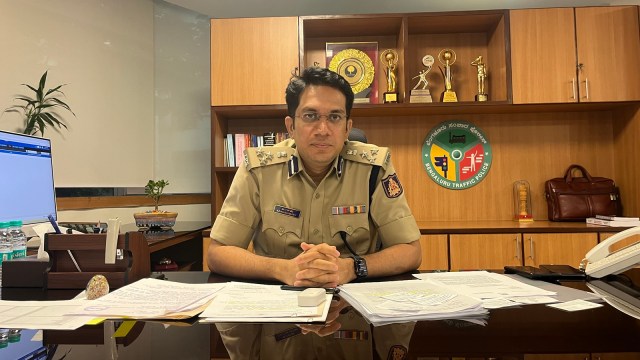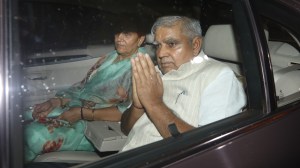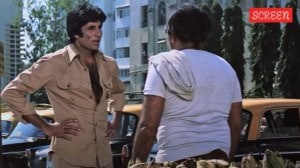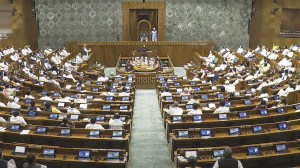‘Boots on the ground first, enforcement secondary’: New Bengaluru traffic chief Karthik Reddy charts plan to address city traffic woes
Karthik Reddy said that from Monday the department is installing ANPR cameras in Ecoworld and EcoSpace tech parks to gauge the exact number of vehicles entering and exiting to manage traffic flow.
 Reddy, a 2011 IPS officer, has served in various capacities throughout his career, but is taking over traffic management for the first time. (Express Photo)
Reddy, a 2011 IPS officer, has served in various capacities throughout his career, but is taking over traffic management for the first time. (Express Photo)An engineering graduate in Electronics and Communication from Bengaluru’s RV College of Engineering, Karthik Reddy is at the helm of traffic management for one of world’s most congested cities – Bengaluru. Reddy, a 2011 IPS officer, has served in various capacities throughout his career, but is taking over traffic management for the first time. He served as the Superintendent of Police (SP) in Bijapur, Tumkur, and Ramanagara. His last posting was as SP Wireless, Bengaluru, where he was involved in steering communication networks with technology across police departments.
Just around three days old to the new job, Reddy has charted out a to-do list to address Bengaluru’s traffic woes. From prioritizing traffic management with the police on ground to reinforcing carpooling and public transport systems, Reddy speaks to The Indian Express on his plan of action. Excerpts from the interview:
Q: What is your primary goal as a traffic chief?
Karthik Reddy: We are focusing on “boots on the ground,” ensuring police presence at major junctions by 7 am to manage early morning traffic. Officers are required to report and send photos to confirm their presence using the ASTRAM application. Additionally, we are strictly enforcing a 2014 government order that prohibits heavy vehicles in the city from 7 am to 11 am and 4.30 pm to 9 pm. Our major role is traffic regulation and management, especially during peak hours. Enforcement is stricter during non-peak hours, but the focus during peak times is on ensuring smoother vehicle movement.
Q: What is your assessment of Bengaluru traffic and what are the major challenges you face?
Reddy: The traffic situation in Bengaluru remains challenging, particularly in areas like the Outer Ring Road (between KR Puram and Silk Board), where congestion is significant. For instance, the 3-4 km stretch near Ecoworld and EcoSpace tech parks takes about 45 minutes to one hour to cross due to heavy vehicle flow, with around 1.6 lakh vehicles daily entering these tech parks alone. From Monday we are installing Automatic Number Plate Recognition (ANPR) cameras in these tech parks to gauge the exact number of vehicles entering and exiting to manage traffic flow. We are planning to see if we can interconnect the tech parks to ensure seamless vehicular flow.
Q: How are you addressing the high vehicle volume in tech park areas like Ecoworld and Ecospace?
Reddy: There are two ways to go about it — short term and long term. In the short term we can ensure easy flow of vehicles into tech parks and then maybe convince the companies to promote carpooling, shuttle bus services and encourage public transport to reduce vehicle numbers, as was done during Covid lockdown. Long-term, is to tap into the big scale mobility infrastructure plan (metro) to reduce congestion.
Q: What are the plans to tackle parking issues contributing to congestion?
Reddy: We are strictly enforcing no-parking rules to prevent road narrowing due to illegal parking, which significantly impacts traffic flow.
Q: How do you handle traffic disruptions caused by civic works and contractors?
Reddy: Contractors often delay completing roadworks or clearing debris, exacerbating congestion. We conduct simulations before approving roadworks to assess diversion impacts. If contractors fail to complete the stalled works within seven days, we will issue notices and may register cases or direct civic agencies to blacklist them.
Q: What measures are being taken to address rain-related traffic congestions?
Reddy: Our staff report waterlogging incidents with photos, which are shared with Bruhat Bengaluru Mahanagara Palike (BBMP) on the Astram app via platforms like Google Maps and MapMyIndia. Notifications are sent to respective BBMP’s assistant engineers to resolve issues promptly. The Astram app is not just for police or commuters, it is for all stakeholders. For this we will be integrating BBMP’s data to improve coordination. Additionally, we are writing to Bengaluru Metropolitan Transport Corporation (BMTC) to place wreckers (tow truck) at six important places which will be pressed into action, when buses or any heavy vehicles breakdown to clear the road during rains.
Q: How effective is adaptive traffic signaling in managing congestion?
Reddy: Adaptive signaling is a machine-learning process, and it’s still learning after 6-7 months of implementation. Manual intervention is used for emergencies, such as clearing paths for ambulances, but 95-96% of the time, we rely on adaptive signaling.
Q: Any plans to keep a tab on violations by delivery riders (eg: Zomato, Swiggy, Zepto)?
Reddy: We’ve launched daily, weekly, and monthly drives targeting violations like footpath riding and one-way traffic breaches by violators.
Q: How do you respond to people moving to other cities like Pune or Hyderabad due to Bengaluru’s traffic?
Reddy: It’s understandable, but commuters should also be aware of the efforts being made to address the situation. Traffic challenges are complex. But we are implementing both short-term and long-term measures to improve flow and reduce congestion.












